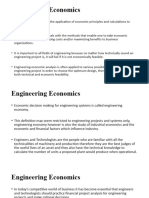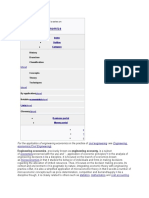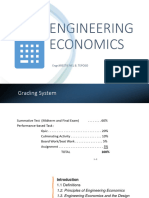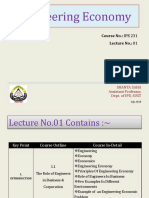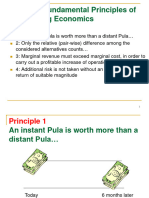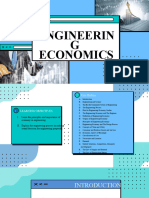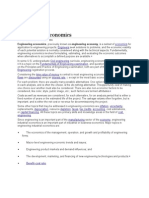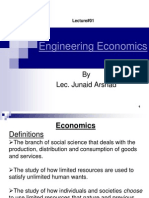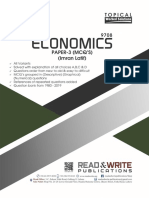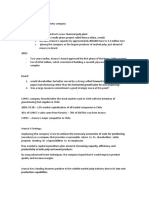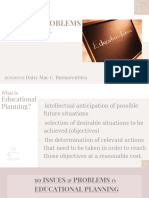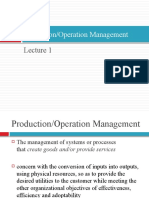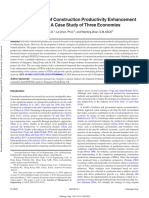Lecture Notes 1
INTRODUCTION
Engineering refers to the application of scientific and mathematical principles to design,
develop, and manage structures, machines, processes, and systems in a way that is both
technically feasible and economically viable. Engineers are responsible for creating solutions
that not only meet the technical requirements but also consider cost-effectiveness, resource
optimization, and long-term sustainability.
Key Points
1. Design and Development – Engineering involves creating and improving products,
systems, or processes that fulfill specific functions while considering constraints such as
materials, cost, and time.
2. Problem-Solving – Engineers apply analytical and creative skills to solve problems in a
way that is practical and efficient, balancing technical performance with economic
considerations.
3. Optimization – Engineering in the context of economics requires optimizing resources,
including time, money, labor, and materials, to achieve the best possible outcome within
the given constraints.
4. Decision-Making – Engineers make informed decisions about design alternatives, project
timelines, and resource allocation by evaluating the economic implications of their
choices. They often use tools like cost-benefit analysis, net present value (NPV), and
internal rate of return (IRR) to assess the financial aspects of engineering projects.
5. Sustainability and Ethics – Engineers must also consider the broader impact of their work,
including environmental sustainability, social responsibility, and ethical implications,
alongside economic efficiency.
Example
An engineer designing a new transportation system must consider not only the technical
specifications (such as capacity, speed, and safety) but also the economic aspects (such
as construction costs, operating expenses, and potential revenue). The goal is to create
a system that meets technical requirements and is financially sustainable.
In summary, Engineering within Engineering Economics focuses on integrating technical
expertise with economic analysis to deliver projects and solutions that are both functional and
economically sound.
In the context of Engineering Economics, Economy refers to the efficient allocation and utilization
of resources—such as money, materials, time, and labor—to achieve the desired objectives in
engineering projects and processes. It involves making informed decisions that optimize costs
and maximize benefits, ensuring that resources are used in the most effective manner possible.
1
�Key Points
1. Resource Allocation – Economy in engineering economics is concerned with how
limited resources are allocated to various engineering activities to achieve the best
possible outcomes. This includes choosing the most cost-effective methods, materials,
and technologies.
2. Cost Management – It involves managing and minimizing costs associated with
engineering projects, including initial capital investment, operating costs, maintenance
expenses, and lifecycle costs, while maintaining quality and performance.
3. Benefit Maximization – Economy also means maximizing the returns or benefits from a
project, such as revenue generation, cost savings, or improved efficiency, relative to the
resources invested.
4. Efficiency – An economic approach in engineering emphasizes achieving the desired
goals with the least amount of waste, whether it’s financial resources, time, or materials.
This can involve optimizing design processes, reducing downtime, and improving
productivity.
5. Trade-Off Analysis – Engineers often need to balance multiple factors, such as cost,
quality, and time. Economy in this context involves analyzing trade-offs to find the most
economically favorable solution that meets the project’s requirements.
Example
Consider a company deciding between two materials for manufacturing a product. One
material is cheaper but less durable, while the other is more expensive but has a longer
lifespan. The economy in engineering economics involves analyzing the total cost over
the product’s lifecycle (including manufacturing, maintenance, and replacement costs) to
determine which material offers the best value.
In summary, Economy within Engineering Economics is about making decisions that ensure the
most efficient use of resources to achieve the best possible outcomes in engineering projects,
balancing cost with performance and long-term sustainability.
Engineering Economics, in the context of Engineering Economics- is the application of economic
principles and techniques to engineering projects and processes. It involves evaluating the cost
and benefits of various alternatives to aid decision-making, ensuring that resources are used
efficiently to achieve optimal economic outcomes. It bridges the gap between engineering design
and economic analysis, helping engineers make sound financial decisions.
Engineering Economics in Agricultural Biosystems Engineering
Illustration: In Agricultural Biosystems Engineering, engineers often work on projects related to
the design, development, and optimization of agricultural systems such as irrigation, farm
machinery, and post-harvest processing facilities. Engineering economics plays a crucial role in
these projects by helping engineers evaluate the financial viability of different options.
Example: Consider a farmer who needs to decide between two types of irrigation systems: a
drip irrigation system and a sprinkler irrigation system. The farmer wants to choose the most
cost-effective option over a 10-year period.
2
� 1. Initial Cost:
o Drip Irrigation: $15,000
o Sprinkler Irrigation: $10,000
2. Annual Operating Costs:
o Drip Irrigation: $2,000 per year
o Sprinkler Irrigation: $3,500 per year
3. Water Savings:
o Drip Irrigation: 30% water savings
o Sprinkler Irrigation: 10% water savings
4. Analysis Using Engineering Economics:
o Calculate the Present Value (PV) of the operating costs for both systems over 10
years, assuming a discount rate of 5%.
o Calculate the Total Cost (initial cost + PV of operating costs) for both systems.
o Compare the total costs and select the system with the lower cost.
If the drip irrigation system has a lower total cost and provides better water savings, engineering
economics helps the farmer make an informed decision that maximizes long-term benefits.
Engineering Economics in Civil Engineering
Illustration: Civil engineers often manage large infrastructure projects such as bridges, roads,
and buildings. These projects require substantial financial investment, and engineering
economics helps in planning, budgeting, and evaluating the economic feasibility of different
design alternatives.
Example: Imagine a city planning to construct a new bridge. The city has two options: a
concrete bridge and a steel bridge.
1. Initial Cost:
o Concrete Bridge: $50 million
o Steel Bridge: $40 million
2. Maintenance Costs:
o Concrete Bridge: $1 million per year
o Steel Bridge: $1.5 million per year
3. Lifespan:
o Concrete Bridge: 50 years
o Steel Bridge: 30 years
4. Analysis Using Engineering Economics:
o Calculate the Net Present Value (NPV) of the maintenance costs for both bridges
over their respective lifespans, assuming a discount rate of 4%.
o Calculate the Equivalent Annual Cost (EAC) for both bridges to compare their
long-term financial impact on the city.
o Consider additional factors such as potential delays, environmental impact, and
availability of materials.
If the NPV and EAC calculations show that the concrete bridge has a lower overall cost despite
its higher initial investment, engineering economics guides the city in making a decision that is
financially sound over the long term.
3
�Summary
In both examples, engineering economics enables engineers to:
• Assess the cost-effectiveness of different solutions.
• Optimize resource allocation.
• Make informed decisions that balance technical requirements with economic
constraints.
References
• Sullivan, W. G., Wicks, E. M., & Koelling, C. P. (2015). Engineering Economy (16th ed.).
Pearson.
• Blank, L., & Tarquin, A. (2012). Basics of Engineering Economy (2nd ed.). McGraw-Hill
Education.
• DeGarmo, E. P., Sullivan, W. G., & Bontadelli, J. A. (1997). Engineering Economy (9th
ed.). Prentice Hall.
• Newnan, D. G., Eschenbach, T. G., & Lavelle, J. P. (2013). Engineering Economic
Analysis (12th ed.). Oxford University Press.
• Park, C. S. (2011). Contemporary Engineering Economics (5th ed.). Pearson.
• Thuesen, G. J., & Fabrycky, W. J. (2001). Engineering Economy (9th ed.). Prentice Hall













